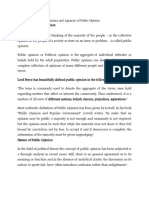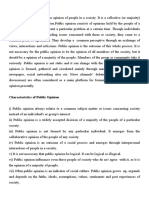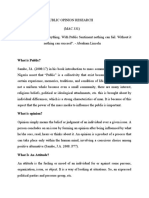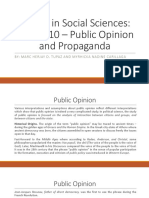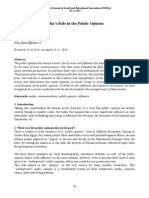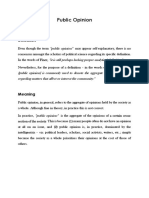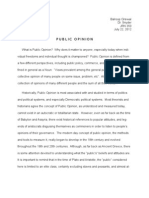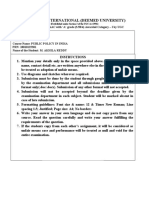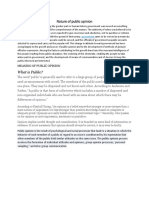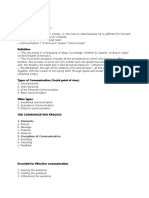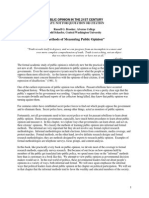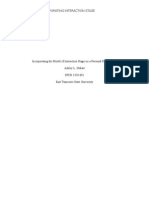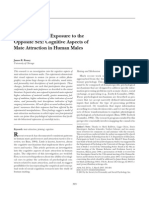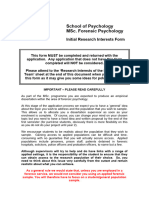TOPIC NO 10
WHAT IS PUBLIC OPINION? HOW IS IT FORMED?
1. BACKGROUND:
The term "public opinion" was derived from the French opinion
publique, which was first used in 1588 by Michel de Montaigne in the
second edition of his Essays. The French term also appears in the
1761 work Julie, or the New Heloise by Jean-Jacques Rousseau
2. PUBLIC OPINION
MEANING OF OPINION:
A. An opinion is a belief somewhat stronger or more intense than a
mere notion or impression but less stronger than positive
knowledge based on complete or adequate proof. Opinions are
really beliefs about a controversial topic.”
B. An opinion is the position—favorable, unfavorable, neutral, or
undecided—people take on a particular issue, policy, action, or
leader. Opinions are not facts; they are expressions of people’s
feelings about a specific political object.
DEFINITION:
A. An aggregate of the individual views, attitudes, and beliefs about
a particular topic, expressed by a significant proportion of a
community.
B. Public opinion is the measure of what the public thinks about a
particular issue, party, or individual political figure.
C. “Opinions held by private persons which governments find it
prudent to heed.”
D. Collective view of a defined population, such as a particular
demographic or ethnic group.
3. VIEWS OF THE JURISTS:
A. William Shakespeare called public opinion the "mistress of
success"
B. Blaise Pascal thought it was "the queen of the world".
C. William Temple says about public opinion. He observed that
"when vast numbers of men submit their lives and fortunes
absolutely to the will of one, it must be force of custom, or
opinion which subjects power to authority".
4. FEATURES OF PUBLIC OPINION:
A. Public opinion is concerned with a matter of public importance. It
is not concerned with the interests of a particular group of
people.
� B. Public opinion is for social welfare. The welfare of society is an
essential characteristic of public opinion.
C. Public opinion is arrived at after careful thought. It is the tentative
deliberative adjustment of public to a situation. It is a logical view
of things. While Lasswell holds that all opinions involve a choice
between different views which may be rationally held, Kimball
Young, on the other hand, is of the view that an opinion may be
rational, or based upon some conviction, or it may proceed from
feeling and emotion.
D. It is cooperative product. It is the product of interaction of human
minds.
E. Public opinion is related to a particular age or times. It is to be
evaluated in the context of a particular situation.
F. Public opinion has a cultural base. The culture of a society
influences public opinion.
G. Lastly, numbers are not necessary to constitute public opinion.
The opinion of even a single person may be called public opinion
though not held by the majority. The opinion of Mahatma Gandhi,
though held by him alone, could be rightly called public opinion.
However, the opinion held by a minority must be shared by the
majority not by force but by conviction.
H. “Public opinion is always moving towards a decision even though
it never is unanimous.”
5. FORMATION OF PUBLIC OPINION:
i. INITIAL PROCESS:
FORMATION OF ATTITUDES
Once an issue is generally recognized, some people will begin to form
attitudes about it. If an attitude is expressed to others by sufficient
numbers of people, a public opinion on the topic begins to emerge.
Not all people will develop a particular attitude about a public issue;
some may not be interested, and others simply may not hear about
it.
ii. FACTORS CONTRIBUTING IN THE INTIAL PROCESS:
a. ENVIRONMENTAL FACTORS
Environmental factors play a critical part in the development of
opinions and attitudes. Most pervasive is the influence of the
social environment: family, friends, neighbourhood, place of
work, religious community, or school. People usually adjust their
attitudes to conform to those that are most prevalent in the social
groups to which they belong.
�b. Democracies tend to make a mystery out of public opinion with
the declaration that “there have been skilled organizers of opinion
who understood the mystery well enough to create majorities on
Election Day.”
c. MASS MEDIA EFFECTS
The formation of public opinion starts with agenda setting by
major media outlets throughout the world.
Public opinion can be influenced by public relations and the
political media. Additionally, mass media utilizes a wide variety of
advertising techniques to get their message out and change the
minds of people. Since the 1950s, television has been the main
medium for molding public opinion.
d. Interest groups
Interest groups, nongovernmental organizations (NGOs), religious
groups, and labour unions (trade unions) cultivate the formation
and spread of public opinion on issues of concern to their
constituencies. These groups may be concerned with political,
economic, or ideological issues, and most work through the mass
media and social media as well as by word of mouth. Some of the
larger or more affluent interest groups around the world make
use of advertising and public relations.
e. INFLUENCE OF INFLUENTIALS:
Public opinion is influenced by "influentials", or persons that have
a significant effect on influencing opinion of the general public
regarding any relevant issues. Many early studies have modeled
the transfer of information from mass media sources to the
general public as a "two-step" process. In this process,
information from mass media and other far-reaching sources of
information influences influentials, and influentials then influence
the general public as opposed to the mass media directly
influencing the public.
f. POLITICAL SOCIALIZATION
Developing your opinions about issues affecting the world around
you is a lifelong process that social scientists call political
socialization
g. BEHAVIORAL GENETICS
People again tend to behave and act as per the values they have
learnt throughout their lives.
h. COMPLEX INFLUENCES
Because psychological makeup, personal circumstances, and
external influences all play a role in the formation of each
�person’s opinions, it is difficult to predict how public opinion on
an issue will take shape. The same is true with regard to changes
in public opinion. Some public opinions can be explained by
specific events and circumstances, but in other cases the causes
are more elusive.





